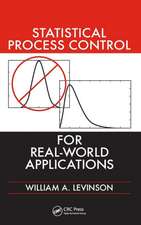Quality by Experimental Design
Autor Thomas B. Barker, Andrew Milivojevichen Limba Engleză Paperback – 30 iun 2021
Written by longtime experimental design guru Thomas B. Barker and experimental development/Six Sigma expert Andrew Milivojevich, Quality by Experimental Design, Fourth Edition shows how to design and analyze experiments statistically, drive process and product innovation, and improve productivity. The book presents an approach to experimentation that assesses many factors, builds predictive models, and verifies the models.
New to the Fourth Edition
- Updated computer programs used to perform simulations, including the latest version of Minitab®
- Four new chapters on mixture experiments: Introduction to Mixture Experiments, The Simplex Lattice Design, The Simplex Centroid Design, and Constrained Mixtures
- Additional exercises and Minitab updates
A Proven, Practical Guide for Newcomers and Seasoned Practitioners in Engineering, Applied Science, Quality, and Six Sigma
This bestselling, applied text continues to cover a broad range of experimental designs for practical use in applied research, quality and process engineering, and product development. With its easy-to-read, conversational style, the book is suitable for any course in applied statistical experimental design or in a Six Sigma program.
| Toate formatele și edițiile | Preț | Express |
|---|---|---|
| Paperback (1) | 436.14 lei 6-8 săpt. | |
| CRC Press – 30 iun 2021 | 436.14 lei 6-8 săpt. | |
| Hardback (1) | 1035.78 lei 6-8 săpt. | |
| CRC Press – 8 feb 2016 | 1035.78 lei 6-8 săpt. |
Preț: 436.14 lei
Nou
Puncte Express: 654
Preț estimativ în valută:
83.47€ • 86.82$ • 68.91£
83.47€ • 86.82$ • 68.91£
Carte tipărită la comandă
Livrare economică 14-28 aprilie
Preluare comenzi: 021 569.72.76
Specificații
ISBN-13: 9781032098050
ISBN-10: 1032098058
Pagini: 754
Ilustrații: 510 Illustrations, black and white
Dimensiuni: 178 x 254 x 43 mm
Greutate: 1.34 kg
Ediția:Nouă
Editura: CRC Press
Colecția Chapman and Hall/CRC
Locul publicării:Boca Raton, United States
ISBN-10: 1032098058
Pagini: 754
Ilustrații: 510 Illustrations, black and white
Dimensiuni: 178 x 254 x 43 mm
Greutate: 1.34 kg
Ediția:Nouă
Editura: CRC Press
Colecția Chapman and Hall/CRC
Locul publicării:Boca Raton, United States
Cuprins
The Philosophy of Experimentation. Statistical Experimental Design. Sorting the Signal from the Noise. The Derivation of Empirical Equations from Statistically Designed Experiments. Utilization of Empirical Equations. Special Topics in Experimental Design Mixture Experiments.
Notă biografică
Thomas B. Barker is a professor emeritus at Rochester Institute of Technology (RIT), where he taught for 35 years before retiring in 2005. Prior to RIT, he was an engineer at Xerox. Visit his website for more information.
Andrew Milivojevich, P.Eng., M.Sc., is the president of The Knowledge Management Group Inc. (TKMG), where he manages R&D, Six Sigma, lean workflow simplification, and other business process improvement initiatives for client organizations. He is a fellow of the American Society for Quality (ASQ) and was the first ASQ-certified Six Sigma Black Belt in Canada. Visit his website for more information.
Andrew Milivojevich, P.Eng., M.Sc., is the president of The Knowledge Management Group Inc. (TKMG), where he manages R&D, Six Sigma, lean workflow simplification, and other business process improvement initiatives for client organizations. He is a fellow of the American Society for Quality (ASQ) and was the first ASQ-certified Six Sigma Black Belt in Canada. Visit his website for more information.
Recenzii
Praise for the Third Edition:
"With a healthy dosage of exclamatory sentences and unique analogies (one even involving Robin Hood and Friar Tuck) in the first pages of the book, the author does not fail to meet expectations."
—Robert G. McLeod, Journal of Quality Technology, Vol. 38, No. 4, October 2006
"What distinguishes this book from other introductory texts in experimental design is its writing style. The book maintains a conversational tone throughout, presenting equations and mathematical derivations only when absolutely necessary. Reading it gives the feeling of attending a seminar or chatting with an expert about a specific topic … The author clearly relishes this approach, and it often works well, making the chapters easy and quick to read and understand. It also has the advantage of appealing to math-phobic readers and anyone trying to avoid feeling lectured. Quality by Experimental Design has a lively style and enough tantalizing material that, I hope, will make beginners in statistics, and practitioners in other engineering areas, interested in picking up more advanced books to get a deeper look at the application of statistically designed experiments to quality control problems."
—Alejandro Heredia-Langner, Technometrics, Vol. 48, No. 4, November 2006
"… an invaluable text … presents a wide variety of techniques and innovative methods for designing and conducting experiments with an expectation of acquiring actionable knowledge. … material is presented in a progressive way that thoughtfully discusses and illustrates proven experimental methods that may be employed to make informed decisions."
—Hank Altland, Retired, Corning, Inc.
"The book is an introduction to the theory of experimental design for practitioners. … The different methods and models are illustrated by a large number of examples and exercises taken from practice. For finding the solutions of the problems, the software package Minitab is used. Application of the methods is supported by various templates and worksheets."
—Zentralblatt MATH, 1088
"This third edition takes the positive aspects of the first edition and adds to them. … a well-written book that can be used for your own reference or as a text."
—From the Foreword by John T. Burr, Assistant Professor, Center for Quality and Applied Statistics, Rochester Institute of Technology
"With a healthy dosage of exclamatory sentences and unique analogies (one even involving Robin Hood and Friar Tuck) in the first pages of the book, the author does not fail to meet expectations."
—Robert G. McLeod, Journal of Quality Technology, Vol. 38, No. 4, October 2006
"What distinguishes this book from other introductory texts in experimental design is its writing style. The book maintains a conversational tone throughout, presenting equations and mathematical derivations only when absolutely necessary. Reading it gives the feeling of attending a seminar or chatting with an expert about a specific topic … The author clearly relishes this approach, and it often works well, making the chapters easy and quick to read and understand. It also has the advantage of appealing to math-phobic readers and anyone trying to avoid feeling lectured. Quality by Experimental Design has a lively style and enough tantalizing material that, I hope, will make beginners in statistics, and practitioners in other engineering areas, interested in picking up more advanced books to get a deeper look at the application of statistically designed experiments to quality control problems."
—Alejandro Heredia-Langner, Technometrics, Vol. 48, No. 4, November 2006
"… an invaluable text … presents a wide variety of techniques and innovative methods for designing and conducting experiments with an expectation of acquiring actionable knowledge. … material is presented in a progressive way that thoughtfully discusses and illustrates proven experimental methods that may be employed to make informed decisions."
—Hank Altland, Retired, Corning, Inc.
"The book is an introduction to the theory of experimental design for practitioners. … The different methods and models are illustrated by a large number of examples and exercises taken from practice. For finding the solutions of the problems, the software package Minitab is used. Application of the methods is supported by various templates and worksheets."
—Zentralblatt MATH, 1088
"This third edition takes the positive aspects of the first edition and adds to them. … a well-written book that can be used for your own reference or as a text."
—From the Foreword by John T. Burr, Assistant Professor, Center for Quality and Applied Statistics, Rochester Institute of Technology
Descriere
This bestseller shows how to design and analyze experiments statistically, drive process and product innovation, and improve productivity. It presents an approach to experimentation that assesses many factors, builds predictive models, and verifies the models. This fourth edition contains four new chapters on mixture experiments, updated compute



























